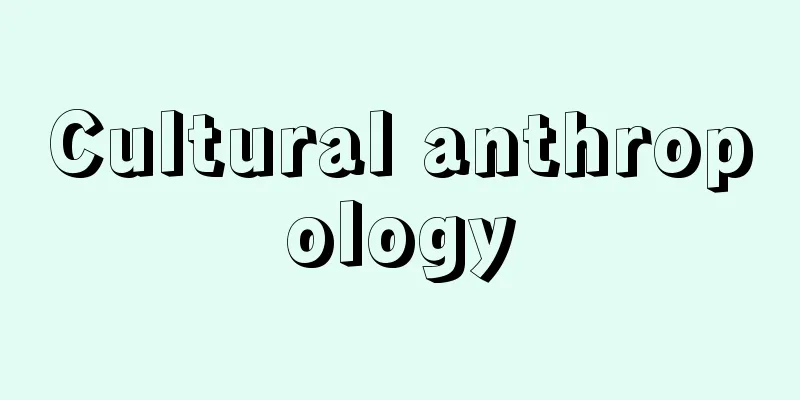Cultural anthropology

|
In the United States, the academic field of cultural anthropology is considered to be included in anthropology. In other words, cultural anthropology is considered to be an academic field that studies the social and cultural aspects of humanity, alongside biological anthropology. Behind this lies the idea that biological research into humanity requires consideration of social and cultural factors, while research into the cultural aspects of humanity requires consideration of its biological conditions. Therefore, even in American universities, anthropology departments include both cultural anthropologists and physical anthropologists. In the United States, cultural anthropology is considered to include prehistoric archaeology, ethnology, social anthropology, ecological anthropology, linguistic anthropology, psychological anthropology, and so on. Prehistoric archaeology studies past cultures through artifacts and ruins, while ethnology is the comparative study of the cultures of primarily primitive peoples. Field surveys of specific societies (primitive societies, village societies, etc.) are called ethnography. Social anthropology focuses on social organizations, including family, kinship, and political organizations, but also studies religion, mythology, and symbolism. Ecological anthropology focuses on the adaptive relationship of societies to their environment. Psychological anthropology was once known as "culture and personality," but since then, research into social perception and cognitive systems has become popular, and it is now called psychological anthropology or cognitive anthropology. Research into cognitive systems is the empirical study of how ethnic groups classify the natural world. For example, there is a detailed report on how the Chertal, a Mayan Indian in Central America, classifies animals and plants. This type of research is also called ethnoscience or ethnosemantics. This type of research attempts to understand how the natural world is classified through the analysis of vocabulary in a particular society. On the other hand, there is also research that attempts to extract classification systems that cannot be grasped through linguistic classification, especially symbolic classifications, through the analysis of ritual activities, and this field is collectively known as symbolic anthropology. In the UK, social anthropology is not considered a branch of cultural anthropology, but is considered an independent field that is different from American cultural anthropology, which includes archaeology and linguistics. Psychological anthropology is also not included. In the UK, the term cultural anthropology is not used, and social anthropology is used as an independent academic term. However, since the 1970s, this difference between the UK and the US has not been strict. In Germany and Austria, the academic field of anthropology refers only to physical anthropology, and ethnology is placed as something that deals with cultural aspects. This ethnology focuses on historical research, so it includes prehistoric archaeology. In Japan, which was initially heavily influenced by German and Austrian scholarship, anthropology and ethnology were divided into two societies, the Japanese Anthropological Society and the Japanese Society of Ethnology, which continue to this day. However, in terms of research content, American cultural anthropology and British and French social anthropology were introduced after the war, and different perspectives coexist. Simply put, the research methods of cultural (social) anthropology consist of field surveys and comparative research. Full-scale field surveys were started by Malinowski and Radcliffe-Brown in the early 20th century. They advocated functionalism, which led to the decline of the evolutionary anthropology that existed before. Functionalism was dominant until relatively recently, but since the structuralism of the French scholar Lévi-Strauss appeared in academia in 1949, it has also come to influence cultural (social) anthropology in the UK and the US. Cultural anthropology can be divided into two opposing methodological streams. One is the scientistic, universalist approach, especially in the United States, which is evident in ecological anthropology and cross-cultural comparative research and emphasizes the scientific method of searching for laws. The other advocates a closer relationship between cultural (social) anthropology and the humanities, and places more importance on interpretation than analysis or explanation. It holds that the aim should be understanding, not searching for laws. The current trends can be summarized as follows: (1) Research on so-called primitive societies and rural areas has now shifted to urban areas, both in non-Western and Western Europe, and research subjects have expanded to include capitalism, gender, nationalism, ethnicity, development, and environmental issues. (2) There is a growing trend to view culture not as something that "exists there" or as an entity, but as a process that is constantly changing, being constructed, and being reconstructed. This tendency naturally leads to greater emphasis on historical research. Although Radcliffe Brown and his successors in the UK and Franz Boas, the founder of American anthropology, and his successors valued research in the present and neglected historical research, many historical studies have been conducted since then, including Marshall Sahlins' (1930-2021) study of the former kingdoms of Fiji and Hawaii, and James J. Fox's (1940- ) study of the political and ecological history of eastern Indonesia. (3) The relationship between anthropology and the colonial period. Also, the research perspective of whether non-Western thought and cosmology can be understood from the standpoint of Western scientific rationalism is recognized. (4) The question has been raised as to whether previous research on Islam and the Middle East by Western anthropologists and others has been biased towards pro-Israel and anti-Arabism. [Teigo Yoshida] "Cultural Anthropology," edited by Sobue Takao and Gamo Masao (1969, Yuhikaku)" ▽ "Social Anthropology," edited by Yoshida Teigo and Gamo Masao (1974, Yuhikaku)" ▽ "Reader in Cultural Anthropology," edited by Yoshida Teigo (1975, Toyo Keizai Shinposha)" ▽ "Guide to Social Anthropology," written by R. E. Leach and translated by Nagashima Nobuhiro (1985, Iwanami Shoten)" ▽ "Encyclopedia of Cultural Anthropology," edited by Ishikawa Sakae, Umesao Tadao, Sobue Takao et al., abridged edition (1994, Kobundo)" ▽ "Keywords in Cultural Anthropology," edited by Yamashita Shinji and Funabiki Takeo, Yuhikaku Series (1997, Yuhikaku)" [References] | | | | | | | | |Source: Shogakukan Encyclopedia Nipponica About Encyclopedia Nipponica Information | Legend |
|
文化人類学という学問は、アメリカでは人類学のなかに含まれるとされている。つまり文化人類学は人類の生物学的人類学と並んで、人類の社会的・文化的側面の研究を行う学問とされている。その背景には、人類の生物学的研究には、社会的・文化的要因の考慮が必要であり、人類の文化的側面の研究には、その生物学的条件の考察が必要であるという考え方が潜んでいる。したがって、アメリカの大学においても、人類学科には、文化人類学者とともに形質人類学者が所属している。文化人類学はアメリカでは先史考古学、民族学、社会人類学、生態人類学、言語人類学、心理人類学などを含むとされている。 先史考古学は、遺物や遺跡を通じて過去の文化を研究し、民族学は主として未開民族の文化を比較研究する。特定の社会(未開社会、村落社会など)の現地調査による研究は民族誌(エスノグラフィー)とよばれている。社会人類学は、家族・親族組織、政治組織などを含む社会組織に重点を置く分野であるが、宗教や神話、シンボリズムの研究も行う。生態人類学は、社会の環境との適応関係を中心に研究する分野である。 心理人類学は、かつて「文化とパーソナリティー」という名称でよばれた分野であるが、その後、社会的知覚や認知体系の研究が盛んになり、最近では心理人類学、認知人類学とよばれている。認知体系の研究というのは、諸民族は自然界をどのように分類しているかを実証的に研究するものである。たとえば中央アメリカのマヤ系インディオであるチェルタルが動植物をどのように分類しているかについて詳しい報告がある。こういう研究はエスノサイエンス、エスノセマンティクスともよばれる。これは、特定の社会における語彙(ごい)の分析を通じて、自然界がいかに分類されているかをとらえようとする。それに対して、言語の分類からは把握できないような分類体系、とくに象徴的分類を儀礼活動の分析を通じて摘出しようとする研究もあり、象徴人類学と総称される分野である。 イギリスでは、社会人類学を文化人類学の一分野とはみなさず、考古学、言語学などを含めるアメリカの文化人類学とは異なる独立の学問と考えられている。心理人類学も含まれていない。イギリスでは文化人類学という名称を使わず、社会人類学を独立の学名としている。しかし1970年以降は、この英米の用語の違いは厳密ではなくなっている。ドイツ・オーストリアでは、人類学という学問は形質人類学だけをさし、文化面を扱うものとして民族学が置かれている。この民族学は歴史的研究を中心にしているので、先史考古学を含んでいる。当初ドイツ・オーストリアの学問の影響の強かった日本では、人類学と民族学を二分して、「日本人類学会」と「日本民族学会」という二つの学会が生まれ、これは現在まで続いている。しかし研究内容としては、戦後にアメリカの文化人類学、イギリスやフランスの社会人類学が導入され、異なる見方が共存している。 文化(社会)人類学の研究法は簡単にいえば現地調査法と比較研究法からなるといえる。本格的な現地調査は20世紀初めにマリノフスキーとラドクリフ・ブラウンによって始められた。彼らによって機能主義が唱えられ、それ以前の進化主義的人類学は衰退した。機能主義は比較的最近まで支配的であったが、フランスのレビ(レヴィ)・ストロースの構造主義が1949年以降学界に登場して以来、イギリス、アメリカの文化(社会)人類学もその影響を受けるようになった。 文化人類学は方法論的に二つの相反する流れに分けることができる。一つは、とくにアメリカにおける科学主義的、普遍主義的アプローチで、これは生態人類学や交差文化的比較研究に顕著であり、法則を求める科学的方法を重視する。もう一つは、文化(社会)人類学の人文学との接近を説き、分析や説明より、解釈を重んずる立場である。法則を求めるのではなく、理解を目ざすべきであるとする。 現在の動向として、以下のようなことがいえる。 (1)いわゆる未開社会や農村の研究から、現在では、非西欧、西欧に限らず都市の調査が盛んになり、研究対象も資本主義、ジェンダー、ナショナリズム、エスニシティ、開発、環境問題などを含むようになった。 (2)どんな文化も「そこに存在するもの」あるいは実体であるかのようにとらえるのでなく、つねに変化し、構成され、再構成されていく過程として文化をみるという考え方が強くなりつつある。この傾向は当然、歴史的研究をいっそう重視することになる。イギリスのラドクリフ・ブラウンとその後継者たち、アメリカの人類学の創設者フランツ・ボアズとその後継者たちは現時点での研究を重んじ、歴史的研究を軽んじたが、その後もサーリンズMarshall Sahlins(1930―2021)のフィジー島やハワイのかつての王国の研究、フォックスJames J. Fox(1940― )の東インドネシアの政治的・生態学的な歴史研究をはじめ、多くの歴史的研究が行われている。 (3)人類学と植民地時代との関係。また西欧的科学合理主義の立場から、非西欧の思考、コスモロジーが理解できるかという研究の視点が認識されている。 (4)従来の西欧の人類学者その他によるイスラムや中近東の研究には、親イスラエル、反アラブ的な偏見があったのではないかという問題提起がなされている。 [吉田禎吾] 『祖父江孝男・蒲生正男編『文化人類学』(1969・有斐閣)』▽『吉田禎吾・蒲生正男編『社会人類学』(1974・有斐閣)』▽『吉田禎吾編『文化人類学読本』(1975・東洋経済新報社)』▽『R・E・リーチ著、長島信弘訳『社会人類学案内』(1985・岩波書店)』▽『石川栄・梅棹忠男・祖父江孝男他編『文化人類学事典』縮刷版(1994・弘文堂)』▽『山下晋司・船曳建夫編『文化人類学キーワード』有斐閣双書(1997・有斐閣)』 [参照項目] | | | | | | | | |出典 小学館 日本大百科全書(ニッポニカ)日本大百科全書(ニッポニカ)について 情報 | 凡例 |
>>: Bunka Shureishu - Bunka Shureishu
Recommend
TRICK
1. A Japanese TV drama series. It is broadcast on ...
Omi Mitsumasa
⇒ Mitsumasa Kodama Source: Kodansha Digital Japane...
"King and not king" - King and not king
...Their tragedies and comedies, which had a uniq...
Salinity - Enbun (English spelling)
Salinity is the total amount of solid matter conta...
Oguni Shinden
…The Oshizawa River flows out from the northeaste...
Gidran
…(3) Anglo-Arab: A hybrid of the Arabian and Thor...
Flower Vocabulary - Kai
...This book also includes dialectal descriptions...
Dinosaurs - Dinosaurs
Dinosaurs are extinct terrestrial reptiles that f...
Magistrate of the Imperial Forest
〘Noun〙 The title of a job in the Edo Shogunate. Th...
Enkidu (English spelling)
He was a close friend of the Babylonian-Assyrian h...
domus
…The most famous example is the ruins of houses i...
Live and let live - Live and let live
...In addition, various diseases such as bacteria...
Yoshibe
...It is located in the mountains on the northern...
Goban doll - Gobanningyo
〘noun〙① A type of entertainment in a tatami room. ...
Kawasoe
The former name of a town (Kawasoe-machi) in Saga...









